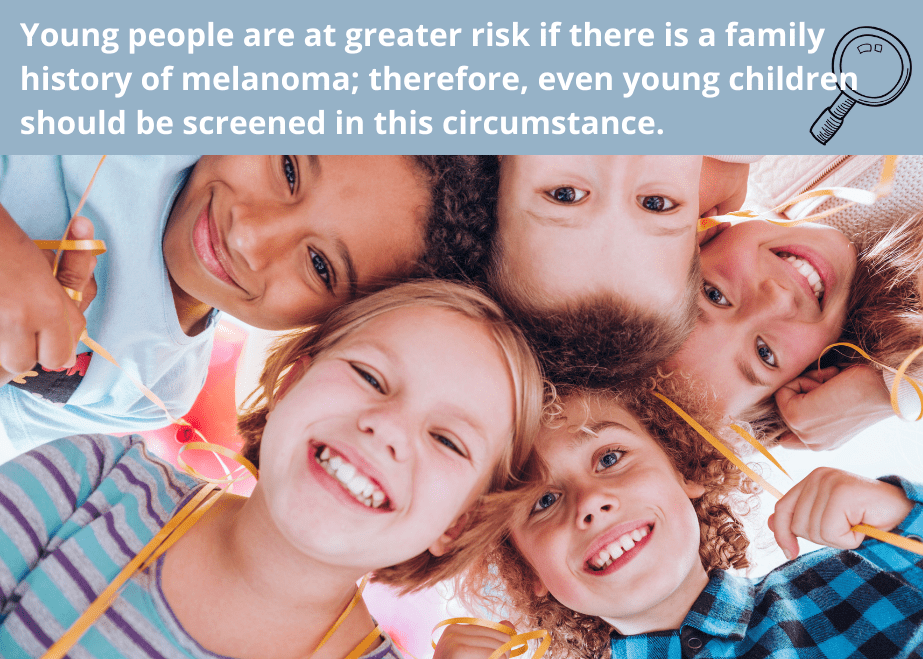Age and Risk

Is Age A Risk Factor for Melanoma?
Melanoma can afflict people of all ages, from the young to the elderly, and everyone in between. Melanoma is often considered a disease of older people, since about half of melanomas occur in people over the age of 50, with the median age at diagnosis being 59. While older adults are at higher risk of developing melanoma, the incidence of melanoma is rapidly rising in young adults. In fact, melanoma is now the third most common form of cancer in men and women aged 15 to 29. So yes, age is a risk factor for melanoma, but the risk of developing the disease is not limited to older adults.
It is estimated that approximately 400 cases of melanoma are diagnosed each year in patients younger than 20 years in the United States, accounting for less than 1% of all new cases of melanoma.[1]
Melanoma annual incidence in the United States (2011–2015) increases with age, as follows[2]:
- Children younger than 10 years: <1.8 cases per 1 million.
- Children aged 10 to 14 years: 3.2 cases per 1 million.
- Children aged 15 to 19 years: 10.4 cases per 1 million.
The incidence of pediatric melanoma increased by an average of 1.7% per year between 1975 and 1994,[2] but then decreased by 0.6% per year from 1995 to 2014.[4]
Melanoma accounts for about 4% of all cancers in children aged 15 to 19 years.[2,3]
The number of children dying from melanoma has fallen significantly over the last 37 years.[5] This improvement is thought to be the result of better education and screening.
Young people are at greater risk if there is a family history of melanoma; therefore, even young children should be screened in this circumstance.

Melanoma is the second most common form of cancer in females age 15-29.[6]
Melanoma incidence is increasing faster in females age 15-29 than in males of the same age group.[7]
Research indicates that the incidence of melanoma in women 18-39 increased 800 percent from 1970 to 2009.[8]
Melanoma in white women younger than 44 has increased 6.1 percent annually, which may reflect recent trends in indoor tanning.[9]
It is the third most common cancer among men and women ages 20-39.[10]
Incidence rates are higher in women than in men before the age of 50, but by age 65, rates in men double those in women, and by age 80 they are triple.[10]
From 2007 to 2016, the incidence rate increased by 2.2% per year in men and women ages 50 and older; however, the rate decreased by 1.2% in men and women younger than age 50.[10]
References:
- National Cancer Institute: SEER Stat Fact Sheets: Melanoma of the Skin. Bethesda, Md: National Cancer Institute.
- Childhood cancer by the ICCC. In: Howlader N, Noone AM, Krapcho M, et al., eds.: SEER Cancer Statistics Review (CSR) 1975-2014. Bethesda, Md: National Cancer Institute, Section 29.
- Bleyer A, O’Leary M, Barr R, et al., eds.: Cancer Epidemiology in Older Adolescents and Young Adults 15 to 29 Years of Age, Including SEER Incidence and Survival: 1975-2000. Bethesda, Md: National Cancer Institute, 2006. NIH Pub. No. 06-5767.
- Wong JR, Harris JK, Rodriguez-Galindo C, et al.: Incidence of childhood and adolescent melanoma in the United States: 1973-2009. Pediatrics 131 (5): 846-54, 2013.
- Lewis KG. Trends in pediatric melanoma mortality in the United States, 1968 through 2004. Dermatol Surg. 2008;34(2):152-159.
- Surveillance, Epidemiology, and End Results (SEER) program 18 registries. Data run July 25, 2018.
- Noone AM, Howlader N, Krapcho M, Miller D, Brest A, Yu M, Ruhl J, Tatalovich Z, Mariotto A, Lewis DR, Chen HS, Feuer EJ, Cronin KA (eds). SEER Cancer Statistics Review, 1975-2015, National Cancer Institute. Bethesda, MD, https://seer.cancer.gov/csr/1975_2015/, based on November 2017 SEER data submission, posted to the SEER web site, April 2018.
- Reed KB et al. Increasing Incidence of Melanoma among Young Adults: An Epidemiological Study in Olmsted County, Minnesota. Mayo Clinic Proceedings, 2012; 87 (4): 328–334.
- Little EG, Eide MJ. Update on the current state of melanoma incidence. Dermatol Clin. 2012:30(3):355-61.
- American Cancer Society. “Cancer Facts and Figures 2020”. Atlanta: American Cancer Society; 2020.

